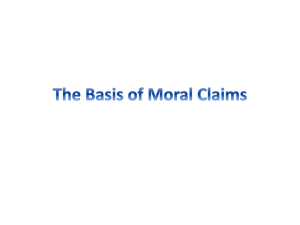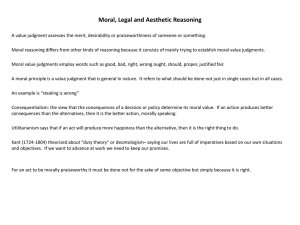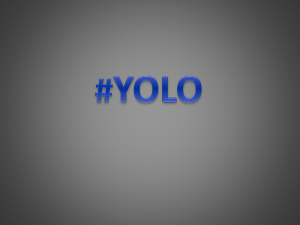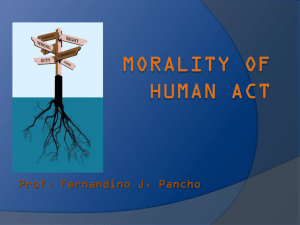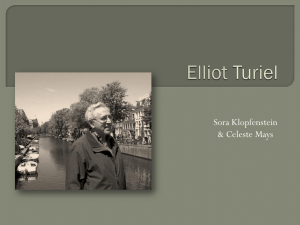Moral Decision
advertisement
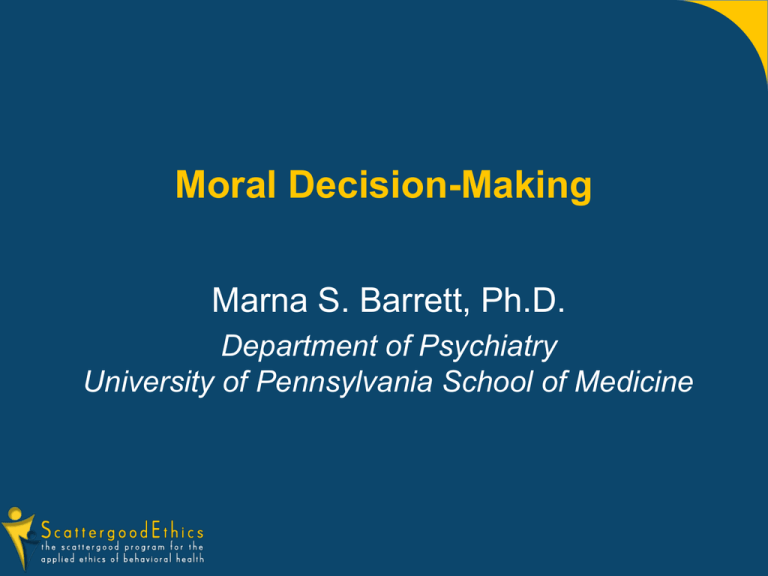
Moral Decision-Making Marna S. Barrett, Ph.D. Department of Psychiatry University of Pennsylvania School of Medicine Moral Decision-Making • What is decision-making? • How is moral decision-making different? • Why do we need a model specific to ethics and mental health? Moral Decision-Making • What is decision-making? – identifying and choosing alternatives based on values and preferences. – process of sufficiently reducing uncertainty and doubt about alternatives to allow a reasonable choice to be made. Moral Decision-Making • How is moral decision-making different? – process for dealing with moral uncertainties – introduces a degree of rationality and rigor into our moral deliberations Moral Decision-Making • Why do we need a model specific to ethics and mental health? – ethical problems require examination through filters (organizational, social, personal, legal) – mental health has unique issues (authority over others, determine social policy, legal influence) Moral Decision-Making Organizing Principles of Ethics Autonomy: right to noninterference, self-determination Beneficence: mercy, kindness, charity to others Empathy: experience the experience of others Fidelity: faithfulness to duties or obligations Justice: benefits, risks, costs distributed fairly Nonmaleficience: avoid harm or risk of harm Universalizability: all moral principles/judgments have universal applicability Moral Decision-Making Ethics Principles inform decisions ♦ Ends -based ♦ Rule-based or Kantian principle ♦ Justice or fairness-based (Aristotle) ♦ Care-based principle (i.e., Golden Rule) ♦ Virtue-based Moral Decision-Making Moral decision-making 1. Most dilemmas are not right vs. wrong but right vs. right dilemmas. - It is right to protect forests, it is right to provide jobs for loggers - It is right to uphold confidentiality, it is right to protect the welfare of others How Good People Make Tough Choices Rushworth M. Kidder, 1995 Moral Decision-Making Moral decision-making 2. Dilemmas often represent competing moral paradigms - Truth vs. Loyalty - Individual vs. Community - Short-term vs. Long-term goals - Justice vs. Mercy Moral Decision-Making I. Standards-based model Based on the assumption that rules, laws, & policies provide the best basis for determining action. ♦ Determine primary dilemma ♦ Spell out ethical standards for response ♦ Determine if there is a reason to deviate ♦ Decide on course of action Moral Decision-Making II. Principles-based model Clarify ♦ Determine dilemma ♦ Formulate alternatives ♦ What key ethical principles and values involved Evaluate ♦ Is any ethical principle violated? ♦ Distinguish facts from beliefs, theories, opinions ♦ Consider credibility of sources ♦ Weigh the benefits, burdens and risks Moral Decision-Making II. Principles-based model (cont’d) Decide ♦ Evaluate alternatives & determine consequences ♦ Prioritize ethical principles/values ♦ Consider the worst case scenario ♦ Apply principles Implement ♦ to maximize benefits & minimize costs & risks Monitor and modify ♦ as new information emerges Moral Decision-Making III. Virtues-based model Considers that dispositions and habits enable us to act according to the highest potential of our character and on behalf of our values. ♦ Virtue ethics asks of any action: --What kind of person will I become if I do this? --Is this action consistent with my acting at my best? ♦ Use virtues in considering options ♦ Make decision accordingly Moral Decision-Making IV. Moral reasoning-based model ♦ Recognize the moral issue ♦ Make a judgment ♦ Establish intent * individual * and situational variables factors of opportunity and significant others Moral Decision-Making IV. Moral reasoning-based model (cont’d) ♦ Moral intensity (effect of decision on others): * concentration of effect (individual or group) * probability of effect (likelihood of harm) * proximity (closeness to the issue) * social consensus (agreement with society) * temporal immediacy (closeness in time) * magnitude of consequence (impact) ♦ Act Moral Decision-Making V. Practice-based model ♦ Recognize problem, get facts ♦ Assess values, benefits, burdens ♦ Determine legal, social influences ♦ Generate solutions, outcomes ♦ Consult ♦ Act, review, reflect Moral Decision-Making Application of a practice-based model Steps 1. Recognize there is a moral issue 2. Determine the actor(s) 3. Gather the relevant facts 4. Test for right-versus-wrong issues 5. Test for right-versus-right paradigms Moral Decision-Making Steps 6. Determine resolution principles involved • • • • • Ends-based Rule-based or Kantian principle Justice or fairness-based Care-based principle Virtue-based 7. Investigate possibilities for action: “trilemma” Moral Decision-Making Steps 8. Consult 9. Weigh benefits & burdens 10. Consider other dilemmas that arise 11. Make the decision Moral Decision-Making Steps 12. Formulate a justification for the decision ♦ ♦ ♦ ♦ List reasons & arguments Recognize shortcomings Anticipate objections Recognize limitations in perspective 13. Document 14. Review and reflect on decision

